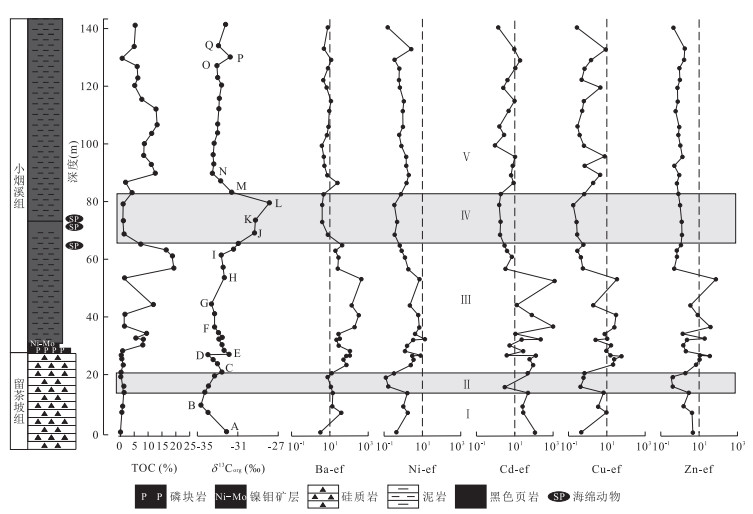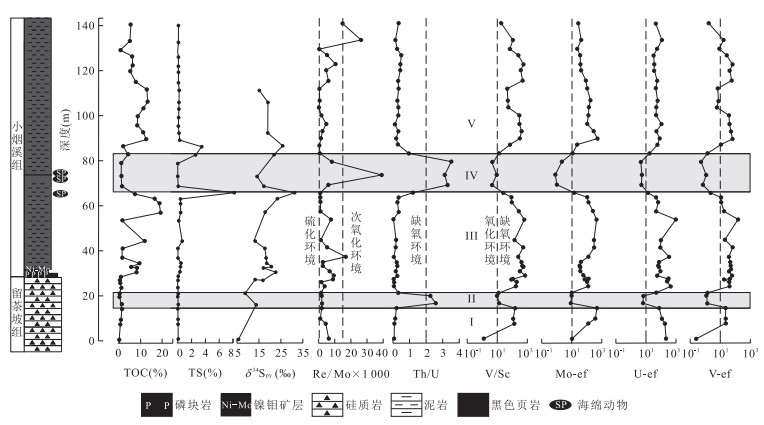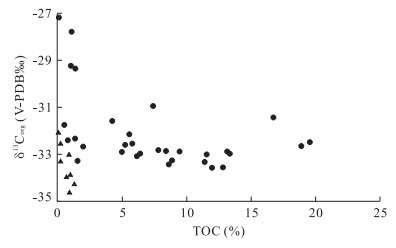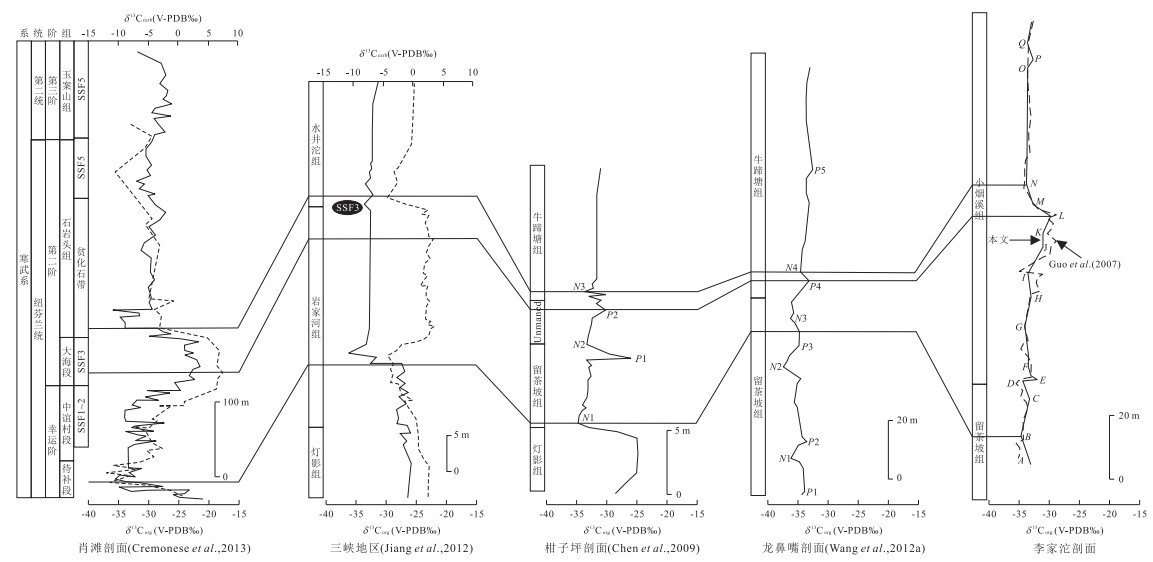Ocean Redox State Evolution and Its Controlling Factors during Cambrian Terreneuvian Epoch: Evidence from Lijiatuo Section, South China
-
摘要: 大气-海洋含氧量的演化对埃迪卡拉纪-寒武纪转折期的后生动物大爆发事件具有重要影响.为探讨寒武纪纽芬兰世中国南方海洋氧化还原性质的演化及其初级生产力、海水硫酸盐浓度等演化驱动因素, 分析了李家沱剖面纽芬兰世留茶坡组和小烟溪组微量元素、有机碳含量、有机碳同位素、总硫含量、黄铁矿硫同位素等.该剖面沉积于斜坡-盆地环境且出露齐全.该剖面上V/Sc、Th/U及Mo、U、V、Ni、Cu等元素的富集系数呈现出5个变化旋回, 其中留茶坡组中上部和小烟溪组中部各存在一氧化环境段, 其余层段处于缺氧环境, 而Re/Mo则显示仅在小烟溪组中部水体出现过短暂的氧化环境和含有游离H2S的硫化环境, 其余层段处于没有游离H2S的缺氧非硫化环境.Ba、Ni、Cu、Zn、Cd等微量元素的富集系数及TOC表明: 留茶坡组的有机质沉降量和埋藏量都明显小于上覆小烟溪组; 而在小烟溪组中, 其中部有机质的沉降量和埋藏量最低, 下部最高, 上部次之.TOC/TS、TS以及黄铁矿硫同位素的垂向演化趋势等都显示李家沱剖面纽芬兰世大都处于低海水硫酸盐浓度环境.低海水硫酸盐浓度是造成李家沱剖面纽芬兰世缺氧水体未富集游离H2S的主要原因.大气含氧量的升高是导致李家沱剖面小烟溪组中部出现短暂氧化环境以及近硫化环境的主要原因.Abstract: The evolution of atmospheric and oceanic oxygen content played an important role in the metazoans' radiation around Ediacaran-Cambrian transition. To explore the vertical stratigraphic evolution and controls of the redox ocean state, primary productivity and seawater sulfate levels during the Terreneuvian epoch, South China, Lijiatuo section, a well-exposed one that is located in the slope and basin environment and consists of mudstones of Xiaoyanxi Formation and cherts of Liuchapo Formation, is selected as the study area for an in-depth analysis of the trace elements, total organic carbon(TOC), organic carbon isotopes, total sulfur(TS) and the sulfur isotope of the pyrite. Based on the ratios of V/Sc, Th/U and the enrichment factors of Mo, U, V, Ni and Cu in the Lijiatuo section, five oxic-anoxic cycles are identified across the Terreneuvian epoch. Except for the middle-upper Liuchapo Formation and the middle Xiaoyanxi Formation, the rest parts of the Lijiatuo section are under anoxic conditions. The Re/Mo ratios demonstrate that the oxic environment of the middle Xiaoyanxi Formation is accompanied by transient sulfidic conditions, and the rest parts of the section are under anoxic and non-sulfidic conditions. All the TOC and the enrichment factors of Ba, Ni, Cu, Zn and Cd demonstrate that both the sink and burial flux of organic matter of Liuchapo Formation are lower than those of the overlying Xiaoyanxi Formation. The highest sink and burial fluxes of organic matter in the Xiaoyanxi Formation appeare in its lower parts, however, whereas the lowest sink and burial fluxes of organic matter in the Xiaoyanxi Formation appeare in its middle parts. The proxies of TOC/TS, TS and the vertical trend of sulfur isotope of pyrite show that the majority of the Lijiatuo section is under low seawater sulfate levels. The low seawater sulfate level was the dominating control for the depletion of free H2S in the majority of the anoxic depositional environment of Lijiatuo section during Terreneuvian epoch. The rise of the atmospheric oxygen content was the principal driver for the coupled, transient oxic and near sulfidic environment in the middle Xiaoyanxi Formation.
-
Key words:
- trace element /
- sulfur isotope of pyrite /
- redox state /
- seawater sulfate level /
- Terreneuvian epoch /
- Lijiatuo section /
- geochemisty
-
图 1 中国南方早中纽芬兰世岩相(a)和晚纽芬兰世岩相古地理分布(b)
据Goldberg et al.(2007)和Jiang et al.(2012)修改.1.沙滩剖面;2.三峡地区;3.柑子坪剖面;4.李家沱剖面;5龙鼻嘴剖面;6.松桃剖面;7.泗里口剖面;8.渣拉沟剖面;9.松林剖面;10.戈仲伍剖面;11.肖滩剖面;12.老林剖面;13.梅树村剖面
Fig. 1. Simplified palaeogeographic map of Yangtze platform during the Early-Middle Terreneuvian epoch (a) and Yangtze platform during the Late Terreneuvian epoch (b)
表 1 李家坨剖面地球化学数据
Table 1. Geochemical data of the Lijiatuo section during the Terreneuvian stage, South China
样品号 样品深度(m) TOC (%) δ13Corg (V-PDB‰) TS (%) δ34Spy (V-CDT‰) Th Mo Mo-ef U U-ef V V-ef Ba Ba-ef Ni Ni-ef L-X-54 140.11 5.4 -32.9 0.1 11.6 24.10 29.70 33.70 45.7 194.0 1.7 4092 7.8 7.70 0.2 L-X-52 132.61 4.9 -32.9 0.1 10.1 30.60 43.30 71.50 111.2 1531.0 15.5 2315 5.0 111.00 2.6 L-X-51 128.71 0.6 -31.8 0.0 4.4 7.69 25.20 16.20 58.3 362.0 8.5 2255 11.4 6.44 0.4 L-X-50 125.91 6.1 -33.1 0.1 6.6 16.30 35.40 13.70 32.7 1682.0 26.1 2379 7.9 18.40 0.7 L-X-48 121.91 6.4 -33.0 0.1 6.0 15.60 37.50 13.60 35.9 3905.0 67.0 1266 4.7 16.00 0.6 L-X-47 119.21 5.2 -32.6 0.1 4.0 11.60 41.50 8.90 35.0 1613.0 41.2 1233 6.8 11.20 0.7 L-X-46 114.61 7.7 -32.8 0.1 3.6 22.40 90.00 12.10 53.4 2041.0 58.6 1892 11.7 15.80 1.1 L-X-44 111.11 13.1 -32.9 0.2 15.1 4.0 32.30 114.90 11.50 45 254.0 6.5 1705 9.3 16.20 1.0 L-X-41 105.81 13.2 -33.0 0.2 19.0 4.8 60.80 183.00 18.70 61.9 348.0 7.5 1852 8.6 19.20 1.0 L-X-39 102.76 11.8 -33.0 0.2 4.7 46.40 140.30 14.50 48.2 275.0 5.9 1558 7.3 12.50 0.6 L-X-38 99.21 8.8 -33.3 0.1 5.8 54.20 134.10 17.30 47 2080.0 36.8 1007 3.8 19.50 0.8 L-X-36 95.36 8.5 -33.5 0.1 4.3 31.60 105.60 28.90 106.1 1708.0 40.8 928 4.8 26.00 1.5 L-X-34 92.15 11.3 -33.4 0.2 18.9 4.7 98.90 299.63 14.80 49.3 2443.0 52.9 1150 5.4 28.90 1.5 L-X-32 88.95 12.7 -33.6 0.2 3.7 136.00 521.40 18.50 77.9 2152.0 58.9 1308 7.7 28.90 1.9 L-X-31 86.15 2.0 -32.7 3.5 25.7 7.9 12.20 22.00 28.40 56.4 818.0 10.6 8947 24.9 49.70 1.5 L-X-29 82.35 4.2 -31.6 2.6 21.9 13.0 10.40 11.40 13.60 16.4 176.0 1.4 2670 4.5 41.90 0.8 L-X-28 78.55 1.1 -27.8 0.0 16.5 2.60 2.20 4.70 4.5 83.5.0 0.5 3082 4.1 24.50 0.4 L-X-26 72.75 1.0 -29.3 0.1 14.2 12.4 0.70 0.80 3.97 5.0 133.0 1.1 2254 4.0 26.90 0.5 L-X-24 68.35 1.4 -29.3 0.1 17.3 12.2 0.90 1.00 3.70 4.8 82.3 0.7 4650 8.4 18.90 0.4 L-X-23 64.75 7.3 -30.9 8.4 31.1 8.0 8.30 15.00 6.70 13.2 172.0 2.2 15751 43.5 23.00 0.7 L-X-21 62.73 16.6 -31.4 0.4 23.4 6.7 53.20 113.40 20.70 48.5 710.0 10.8 6151 20.2 23.90 0.9 L-X-19 60.53 18.7 -32.7 0.4 5.7 51.90 131.40 22.80 63.4 618.0 11.2 7277 28.3 29.00 1.2 L-X-18 56.53 19.4 -32.5 0.4 17.8 4.1 76.60 264.60 12.60 47.8 729.0 18.0 5037 26.8 33.50 1.9 L-X-17 52.93 1.4 -32.3 0.2 0.4 12.10 460.20 23.00 961.3 544.0 147.8 7420 434.2 11.40 7.2 L-X-16 43.93 11.9 -33.6 0.7 13.1 2.7 58.20 314.10 16.80 99.6 525.0 20.2 16882 140.2 25.70 2.3 L-X-14 40.53 1.6 -33.3 0.1 17.8 0.3 5.70 323.20 1.50 93.0 154.0 62.9 3641 320.4 6.90 6.6 L-X-11 36.41 1.6 -33.1 0.1 18.2 0.3 2.80 131.60 6.80 353.4 108.0 36.7 2534 185.2 9.80 7.7 L-X-09 34.06 9.4 -32.9 0.5 18.5 2.7 7.60 40.70 12.10 71.2 1208.0 46.2 3420 28.2 46.20 4.1 L-X-07 32.41 5.7 -32.5 0.4 20.6 1.0 2.40 34.30 4.00 64.2 475.0 49.6 1444 32.5 50.90 12.4 L-X-05 31.95 8.3 -32.9 0.5 17.2 3.2 8.40 38.00 14.40 71.8 1499.0 48.6 3204 22.4 40.60 3.1 L-X-03 29.98 8.1 -32.4 0.4 22.7 3.4 9.10 38.90 19.60 92.2 1265.0 38.7 4256 28.0 21.60 1.5 L-X-02 28.08 0.8 -32.4 0.1 1.0 4.30 62.30 3.50 54.9 577.0 59.7 5101 113.7 4.80 1.2 L-X-01 26.48 0.1 -31.2 0.0 13.1 0.2 2.00 148.30 4.00 333.3 78.9 42.4 906 104.9 6.60 8.3 L-L-12 26.45 0.7 -34.0 0.1 16.8 0.2 0.80 72.90 2.80 280.8 26.0 17.1 485 68.8 1.90 3.0 L-L-11 25.20 0.5 -33.5 0.0 0.3 1.90 105.80 4.40 275.9 96.7 39.5 570 50.2 3.60 3.4 L-L-10 23.20 0.9 -33.0 0.0 0.4 3.70 125.60 11.50 431.3 167.0 40.7 1405 73.8 4.30 2.4 L-L-09 20.50 0.3 -32.6 0.1 8.43 2.5 1.80 10.30 7.40 47.0 34.2 1.4 1447 12.9 3.50 0.3 L-L-08 19.10 0.3 -33.3 0.0 3.0 2.10 10.10 1.30 7.0 35.6 1.2 1050 7.6 1.70 0.1 L-L-07 15.70 1.0 -33.9 0.1 13.80 2.4 1.40 8.40 0.90 6.1 32.3 1.4 1252 11.5 1.80 0.2 L-L-06 13.60 1.3 -34.3 0.1 0.5 18.40 489.10 2.60 75.9 113.0 21.5 365 14.9 3.60 1.6 L-L-04 9.00 0.9 -34.7 0.0 0.8 21.10 379.50 5.60 111.1 177.0 22.7 478 13.2 3.40 1.0 L-L-03 6.70 0.7 -34.0 0.0 0.8 7.00 131.90 9.30 193.0 165.0 22.2 1357 39.3 5.20 1.6 L-L-01 0.0 0.1 -32.1 0.1 5.90 5.5 4.10 10.50 76.20 216.9 13.1 0.2 820 3.3 9.80 0.4 样品号 样品深度(m) Cd Cd-ef Cu Cu-ef Zn Zn-ef Sc V/Sc Th/U Re Re/Mo×1000 L-X-54 140.11 0.1 1.4 17.9 0.3 28.3 0.90 10.5 18.5 0.3 0.353 14.7 L-X-52 132.61 0.7 9.4 464.0 8.8 101.0 3.86 14.2 107.8 0.1 0.803 26.2 L-X-51 128.71 0.6 19.5 35.4 1.5 39.7 3.30 5.5 65.5 0.3 0.005 0.7 L-X-50 125.91 0.5 11.1 25.0 0.7 31.0 1.70 6.4 262.8 0.5 0.083 5.1 L-X-48 121.91 0.2 4.5 15.1 0.5 31.4 1.90 6.8 570.9 0.4 0.164 10.5 L-X-47 119.21 0.1 2.6 94.9 4.5 16.4 1.50 4.3 376.0 0.5 0.054 4.7 L-X-46 114.61 0.2 9.6 12.4 0.7 14.6 1.50 4.4 467.1 0.3 0.137 6.1 L-X-44 111.11 0.1 4.8 10.5 0.5 13.6 1.20 5.4 47.5 0.4 0.021 0.7 L-X-41 105.81 0.1 1.6 7.4 0.3 23.7 1.80 7.2 48.6 0.3 0.041 0.7 L-X-39 102.76 0.1 2.8 9.5 0.4 20.0 1.50 5.1 53.7 0.3 0.013 0.3 L-X-38 99.21 0.1 1.0 20.3 0.7 35.0 2.20 7.1 293.0 0.3 0.088 1.6 L-X-36 95.36 0.3 10.6 175.0 7.8 31.5 2.60 5.6 305.0 0.2 0.149 4.7 L-X-34 92.15 0.3 7.9 18.3 0.7 13.0 1.00 5.7 431.6 0.3 0.235 2.4 L-X-32 88.95 0.2 6.6 83.1 4.3 17.7 1.70 6.9 312.8 0.2 0.211 1.6 L-X-31 86.15 0.5 8.7 79.5 1.9 30.0 1.40 11.6 70.5 0.3 0.009 0.7 L-X-29 82.35 0.2 1.8 44.6 0.7 56.8 1.60 13.4 13.1 1.0 0.009 0.9 L-X-28 78.55 0.2 1.5 15.0 0.2 86.2 1.90 18.5 4.5 3.5 0.021 8.2 L-X-26 72.75 0.2 1.9 16.7 0.3 83.0 2.40 14.9 8.9 3.1 0.027 39.1 L-X-24 68.35 0.2 1.8 18.6 0.3 83.6 2.50 18.3 4.5 3.3 0.005 5.8 L-X-23 64.75 0.2 2.9 25.2 0.6 46.1 2.10 6.7 25.8 1.2 0.009 1.1 L-X-21 62.73 0.2 3.9 10.6 0.3 23.2 1.20 8.2 86.5 0.3 0.053 1.0 L-X-19 60.50 0.3 7.3 13.3 0.5 20.4 1.30 6.7 91.8 0.3 0.055 1.1 L-X-18 56.53 0.1 3.5 12.1 0.6 11.1 1.00 2.7 266.1 0.3 0.094 1.2 L-X-17 52.93 5.1 1935.8 63.8 32.4 160.0 152.10 0.9 635.5 0.1 0.094 7.8 L-X-16 43.93 0.2 13.0 27.1 2.0 47.9 6.50 3.7 140.4 0.2 0.057 1.0 L-X-14 40.53 0.1 81.2 39.5 30.1 11.3 16.20 0.3 532.9 0.2 0.030 5.3 L-X-11 36.41 3.5 1662.8 39.1 24.8 62.4 74.10 0.4 244.3 0.1 0.047 17.0 L-X-09 34.06 0.2 11.3 105.0 7.5 20.7 2.80 3.0 408.1 0.2 0.020 2.6 L-X-07 32.41 1.6 236.6 52.9 10.3 100.0 36.50 1.1 443.9 0.2 0.006 2.6 L-X-05 31.95 0.5 21.9 41.7 2.5 39.3 4.50 2.8 543.1 0.2 0.027 3.2 L-X-03 29.98 0.1 4.9 287.0 16.4 26.2 2.80 4.1 310.8 0.2 0.063 6.9 L-X-02 28.08 0.2 27.1 51.3 9.9 10.7 3.90 0.8 726.7 0.3 0.040 9.3 L-X-01 26.48 0.1 3.8 15.5 15.6 36.2 68.10 0.7 111.1 0.1 -- -- L-L-12 26.45 0.1 120.9 46.6 57.3 8.9 20.60 0.3 85.3 0.1 0.007 8.9 L-L-11 25.20 0.1 60.6 30.6 23.3 14.6 20.90 0.5 202.3 0.1 0.003 1.6 L-L-10 23.20 0.3 93.5 47.7 21.7 15.0 12.80 1.0 173.4 0.1 0.014 3.8 L-L-09 20.50 0.8 48.2 9.1 0.7 26.0 3.80 3.0 11.6 0.3 0.003 1.7 L-L-08 19.10 -- -- 9.41 0.6 6.3 0.80 3.8 9.4 2.3 0.004 1.9 L-L-07 15.70 0.1 3.3 5.5 0.4 5.6 0.80 2.6 12.5 2.6 0.003 2.1 L-L-06 13.60 0.2 48.9 18.6 6.6 8.7 5.80 0.7 156.7 0.2 0.034 1.9 L-L-04 9.00 0.2 26.8 14.3 3.4 6.6 3.00 1.6 114.2 0.1 0.020 1.0 L-L-03 6.70 0.2 29.0 37.3 9.4 17.6 8.30 1.2 135.3 0.1 0.031 4.4 L-L-01 0 4.4 114.2 14.1 0.5 142.0 9.20 10.5 1.3 0.1 0.025 6.2 注:微量元素含量单位为10-6. -
Algeo, T.J., Lyons, T.W., 2006. Mo-Total Organic Carbon Covariation in Modern Anoxic Marine Environments: Implications for Analysis of Paleoredox and Paleohydrographic Conditions. Paleoceanography, Palaeoclimatology, Palaeoecology, 21: 1-23. doi: 10.1029/2004PA001112 Algeo, T.J., Tribovillard, N., 2009. Environmental Analysis of Paleoceanographic Systems Based on Molybdenum-Uranium Covariation. Chemical Geology, 268: 211-225. doi: 10.1016/j.chemgeo.2009.09.001 Algeo, T.J., Henderson, C.M., Tong, J.N., et al., 2013. Plankton and Productivity during the Permian-Triassic Boundary Crisis: An Analysis of Organic Carbon Fluxes. Global and Planetary Change, 105: 52-67. doi: 10.1016/j.gloplacha.2012.02.008 Anbar, A.D., Knoll, A.H., 2002. Proterozoic Ocean Chemistry and Evolution: A Bioinorganic Bridge. Science, 297: 1137-1142. doi: 10.1126/science.1069651 Berner, R.A., Raiswell, R., 1984. C/S Method for Distinguishing Fresh Water from Marine Sedimentary Rocks. Geology, 12: 365-368. doi:10.1130/0091-7613(1984)12<365:CMFDFF>2.0.CO;2 Berner, R.A., 2009. Phanerozoic Atmospheric Oxygen: New Results Using the Geocarbsulf Model. American Journal of Science, 309: 603-606. doi: 10.2475/07.2009.03 Canfield, D.E., Poulton, S.W., Knoll, A.H., et al., 2008. Ferruginous Conditions Dominated Later Neoproterozoic Deep Water Chemistry. Science, 321: 949-952. doi: 10.1126/science.1154499 Canfield, D.E., Raiswell, R., Westrich, J.T., et al., 1986. The Use of Chromium Reduction in the Analysis of Reduced Inorganic Sulfur in Sediments and Shales. Chemical Geology, 54: 149-155. doi: 10.1016/0009-2541(86)90078-1 Canfield, D.E., Teske, A., 1996. Late Proterozoic Rise in Atmospheric Oxygen Concentration Inferred from Phylogenetic and Sulphur Isotope Studies. Nature, 382: 127-132. doi: 10.1038/382127a0 Cao, C.Q., Love, G.D., Hays, L.E., et al., 2009. Biogeochemical Evidence for Euxinic Oceans and Ecological Disturbance Presaging the End-Permian Mass Extinction Event. Earth and Planetary Science Letters, 281: 188-201. doi: 10.1016/j.epsl.2009.02.012 Chang, H.J., Chu, X.L., Feng, L.J., et al., 2009. Terminal Ediacaran Anoxia in Deep Ocean: Trace Element Evidence from Cherts of the Liuchapo Formation, South China. Science in China (Series D), 52: 807-822. doi: 10.1007/s11430-009-0070-7 Chang, H.J., Chu, X.L., Feng, L.J., et al., 2009. Framboidal Pyrites in Cherts of the Laobao Formation, South China: Evidence for Anoxic Deep Ocean in the Terminal Ediacaran. Acta Petrologica Sinica, 25(4): 1001-1007(in Chinese with English abstract). http://d.wanfangdata.com.cn/periodical/ysxb98200904024 Chang, H.J., Chu, X.L., Feng, L.J., et al., 2010. Iron Speciation in Cherts from the Laobao Formation. Chinese Science Bulletin, 55: 3189-3196. doi: 10.1007/s11434-010-4006-6 Chang, H.J., Chu, X.L., Feng, L.J., et al., 2012. Progressive Oxidation of Anoxic and Ferruginous Deep Water during Deposition of the Terminal Ediacaran Laobao Formation in South China. Palaeogeography, Palaeoclimatology, Palaeoecology, 321: 80-87. doi: 10.1016/j.palaeo.2012.01.019 Chen, D.Z., Wang, J.G., Qing, H.R., et al., 2009. Hydrothermal Venting Activities in the Early Cambrian, South China: Petrological, Geochronological and Stable Isotopic Constraints. Chemical Geology, 258: 168-181. doi: 10.1016/j.chemgeo.2008.10.016 Cremonese, L., Shields-Zhou, G.A., Struck, U., et al., 2013. Marine Biogeochemical Cycling during the Early Cambrian Constrained by a Nitrogen and Organic Carbon Isotope Study of the Xiaotan Section, South China. Precambrian Research, 225: 148-165. doi: 10.1016/j.precamres.2011.12.004 Deng, Y.N., Guo, Q.J., Zhu, M.Y., et al., 2014. REE Geochemistry of Kerogen from Early Cambrian Black Rock Series in Western Hunan. Earth Science—Journal of China University of Geosciences, 39(3): 283-292. doi: 10.3799/dqkx.2014.027 Grice, K., Cao, C.Q., Love, G.D., et al., 2005. Photic Zone Euxinia during the Permian-Triassic Superanoxic Event. Science, 307: 706-709. doi: 10.1126/science.1104323 Galimov, E.M., 2004. The Pattern of δ13Corg versus HI/OI Relation in Recent Sediments as an Indicator of Geochemical Regime in Marine Basins: Comparison of the Black Sea, Kara Sea, and Cariaco Trench. Chemical Geology, 204: 287-301. doi: 10.1016/j.chemgeo.2003.11.014 Goldberg, T., Strauss, H., Guo, Q.J., et al., 2007. Reconstructing Marine Redox Conditions for the Early Cambrian Yangtze Platform: Evidence from Biogenic Sulphur and Organic Carbon Isotopes. Palaeogeography, Palaeoclimatology, Palaeoecology, 254: 175-193. doi: 10.1016/j.palaeo.2007.03.015 Gong, C., Hollander, D. J, . 1997. Differential Contribution of Bacteria to Sedimentary Organic Matter in Oxic and Anoxic Environments, Santa Monica Basin, California. Organic Geochemistry, 26: 545-563. doi: 10.1016/S0146-6380(97)00018-1 Guo, Q.J., Shields, G.A., Liu, C.Q., et al., 2007a. Trace Element Chemostratigraphy of Two Ediacaran-Cambrian Successions in South China: Implications for Organosedimentary Metal Enrichment and Silicification in the Early Cambrian. Palaeogeography, Palaeoclimatology, Palaeoecology, 254: 194-216. doi: 10.1016/j.palaeo.2007.03.016 Guo, Q.J., Strauss, H., Liu, C.Q., et al., 2007b. Carbon Isotopic Evolution of the Terminal Neoproterozoic and Early Cambrian: Evidence from the Yangtze Platform, South China. Palaeogeography, Palaeoclimatology, Palaeoecology, 254: 140-157. doi: 10.1016/j.palaeo.2007.03.014 Guo, Q.J., Strauss, H., Zhu, M.Y., et al., 2013. High Resolution Organic Carbon Isotope Stratigraphy from a Slope to Basinal Setting on the Yangtze Platform, South China: Implications for the Ediacaran-Cambrian Transition. Precambrian Research, 225: 209-217. doi: 10.1016/j.precamres.2011.10.003 Ishikawa, T., Ueno, Y., Komiya, T., et al., 2008. Carbon Isotope Chemostratigraphy of a Precambrian/Cambrian Boundary Section in the Three Gorges Area, South China: Prominent Global Scale Isotope Excursions just before the Cambrian Explosion. Gondwana Research, 14: 193-208. doi: 10.1016/j.gr.2007.10.008 Jiang, G.Q., Wang, X.Q., Shi, X.Y., et al., 2012. The Origin of Decoupled Carbonate and Organic Carbon Isotope Signatures in the Early Cambrian (ca. 542-520Ma) Yangtze Platform. Earth and Planetary Science Letters, 317-318: 96-110. doi: 10.1016/j.epsl.2011.11.018 Jiang, S.Y., Pi, D.H., Heubeck, C., et al., 2009. Early Cambrian Ocean Anoxia in South China. Nature, 459: E5-E6. doi: 10.1038/nature08048 Johnston, D.T., Poulton, S.W., Dehler, C., et al., 2010. An Emerging Picture of Neoproterozoic Ocean Chemistry, Insights from the Chuar Group, Grand Canyon, USA. Earth and Planetary Science Letters, 290: 64-73. doi: 10.1016/j.epsl.2009.11.059 Kouchinsky, A., Bengtson, S., Runnegar, B., et al., 2012. Chronology of Early Cambrian Biomineralization. Geological Magazine, 149: 221-251. doi: 10.1017/S0016756811000720 Kimura, H., Watanabe, Y., 2001. Oceanic Anoxia at the Precambrian-Cambrian Boundary. Geology, 29: 995-998. doi:10.1130/0091-7613(2001)029<0995:OAATPC>2.0.CO;2 Kump, L.R., Junium, C., Arthur, M.A., et al., 2011. Isotopic Evidence for Massive Oxidation of Organic Matter Following the Great Oxidation Event. Science, 334: 1694-1696. doi: 10.1126/science.1213999 Lehmann, M.F., Bernasconi, S.M., Barbieri, A., et al., 2002. Preservation of Organic Matter and Alteration of Its Carbon and Nitrogen Isotope Composition during Simulated and In-Situ Early Sedimentary Diagenesis. Geochimica et Cosmochimica Acta, 66: 3573-3584. doi: 10.1016/S0016-7037(02)00968-7 Li, C., Love, G.D., Lyons, T.W., et al., 2010. A Stratified Redox Model for the Ediacaran Ocean. Science, 328: 80-83. doi: 10.1126/science.1182369 Li, D., Ling, H.F., Jiang, S.Y., et al., 2009. New Carbon Isotope Stratigraphy of the Ediacaran-Cambrian Boundary Interval from SW China: Implications for Global Correlation. Geological Magazine, 146: 465-484. doi: 10.1017/S0016756809006268 Li, D., Ling, H.F., Shields-Zhou, G.A., et al., 2013. Carbon and Strontium Isotope Evolution of Seawater across the Ediacaran-Cambrian Transition: Evidence from the Xiaotan Section, NE Yunnan, South China. Precambrian Research, 225: 128-147. doi: 10.1016/j.precamres.2012.01.002 Li, G.X., Steiner, M., Zhu, X., et al., 2007. Early Cambrian Metazoan Fossil Record of South China: Generic Diversity and Radiation Patterns. Palaeogeography, Palaeoclimatology, Palaeoecology, 254: 229-249. doi: 10.1016/j.palaco.2007.03.017 Luo, H.L., Jiang, Z.W., Wu, X.C., 1984. Sinian-Cambrian Boundary Stratotype Section at Meishucun, Jinning, Yunnan, China. Yunnan People's Publishing House, Kunming(in Chinese). März, C., Poulton, S.W., Beckmann, B., et al., 2008. Redox Sensitivity of P Cycling during Marine Black Shale Formation: Dynamics of Sulfidic and Anoxic, Non-Sulfidic Bottom Waters. Geochimica et Cosmochimica Acta, 72: 3703-3717. doi: 10.1016/j.gca.2008.04.025 Marshall, C.R., 2006. Explaining the Cambrian "Explosion" of Animals. Annual Review of Earth and Planetary Sciences, 34: 355-384. doi: 10.1146/annurev.earth.33.031504.103001 Morford, J.L., Martin, W.R., Carney, C.M., 2012. Rhenium Geochemical Cycling: Insights from Continental Margins. Chemical Geology, 324: 73-86. doi: 10.1016/j.chemgeo.2011.12.014 Muńoz, P., Dezileau, L., Lange, C., et al., 2012. Evaluation of Sediment Trace Metal Records as Paleoproductivity and Paleoxygenation Proxies in the Upwelling Center off Concepcion, Chile (36°S). Progress in Oceanography, 92-95: 66-80. doi: 10.1016/j.pocean.2011.07.010 Och, L., Shields-Zhou, G.A., Poulton, S.W., et al., 2013. Redox Changes in Early Cambrian Black Shales at Xiaotan Section, Yunnan Province, South China. Precambrian Research, 225: 166-189. doi: 10.1016/j.precamres.2011.10.005 Ogg, J.G., Ogg, G., Gradstein, F.M., 2008. The Concise Geologic Time Scale. Cambridge University Press, Cambridge, 177. Pang, W.H., Ding, X.Z., Gao, L.Z., et al., 2011. Characteristics of Sequence Stratigraphy and Palaeoenvironmental Evolution of Lower Cambrian Strata in Hunan Province. Geology in China, 38(3): 560-576(in Chinese with English abstract). http://www.researchgate.net/publication/289077887_Characteristics_of_Sequence_Stratigraphy_and_Plaeoenvironmental_Evolution_of_Lower_Cambrian_strata_in_Hunan_Province Peng, S.C., 2009. The Newly-Developed Cambrian Biostratigraphic Succession and Chronostratigraphic Scheme for South China. Chinese Science Bulletin, 54(18): 2691-2698(in Chinese). doi: 10.1007/s11434-009-0667-4 Peng, S.C., Babcock, L.E., 2011. Continuing Progress on Chronostratigraphic Subdivision of the Cambrian System. Bulletin Geoscience, 86: 391-396. doi: 10.3140/bull.geosci.1273 Pi, D.H., Liu, C.Q., Shields-Zhou, G.A., et al., 2013. Trace and Rare Earth Element Geochemistry of Black Shale and Kerogen in the Early Cambrian Niutitang Formation in Guizhou Province, South China: Constraints for Redox Environments and Origin of Metal Enrichments. Precambrian Research, 225: 218-229. doi: 10.1016/j.precamres.2011.07.004 Piper, D.Z., Calvert, S.E., 2009. A Marine Biogeochemical Perspective on Black Shale Deposition. Earth-Science Reviews, 95: 63-96. doi: 10.1016/j.earscirev.2009.03.001 Planavsky, N.J., Rouxel, O.J., Bekker, A.L., et al., 2010. The Evolution of the Marine Phosphate Reservoir. Nature, 467: 1088-1090. doi: 10.1038/nature09485 Planavsky, N.J., McGoldrick, P., Scott, C.T., et al., 2011. Widespread Iron-Rich Conditions in the Mid-Proterozoic Ocean. Nature, 477: 448-451. doi: 10.1038/nature10327 Qian, Y., Yin, G.Z., 1984. Small Shelly Fossils from the Lowest Cambrian in Guizhou. In: Hao, Y.C., ed., Stratigraphy and Palaeontology Proceedings. Geological Publishing House, Beijing, 91-123 (in Chinese). Qian, Y., Zhu, M.Y., Li, G.X., et al., 2002. A Supplemental Precambrian-Cambrian Boundary Global Stratotype Section in SW China. Acta Palaeontologica Sinica, 41(1): 19-26(in Chinese with English abstract). http://europepmc.org/abstract/cba/368400 Raiswell, R., Berner, R.A., 1985. Pyrite Formation in Euxinic and Semi-Euxinic Sediments. American Journal of Science, 285: 710-724. doi: 10.2475/ajs.285.8.710 Riquier, L., Tribovillard, N., Averbuch, O., et al., 2006. The Late Frasnian Kellwasser Horizons of the Harz Mountains (Germany): Two Oxygen Deficient Periods Resulting from Different Mechanisms. Chemical Geology, 233: 137-155. doi: 10.1016/j.chemgeo.2006.02.021 Ross, D.J.K., Bustin, R.M., 2009. Investigating the Use of Sedimentary Geochemical Proxies for Paleoenvironment Interpretation of Thermally Mature Organic-Rich Strata: Examples from the Devonian-Mississippian Shales, Western Canadian Sedimentary Basin. Chemical Geology, 260: 1-19. doi: 10.1016/j.chemgeo.2008.10.027 Saltzman, M.R., 2005. Phosphorus, Nitrogen, and the Redox Evolution of the Paleozoic Oceans. Geology, 33: 573-576. doi: 10.1130/G21535.1 Sepúlveda, J., Wendler, J.E., Summons, R.E., et al., 2009. Rapid Resurgence of Marine Productivity after the Cretaceous-Paleogene Mass Extinction. Science, 326: 129-132. doi: 10.1126/science.1176233 Shen, S.Z., Crowley, J.L., Wang, Y., et al., 2011. Calibrating the End-Permian Mass Extinction. Science, 334: 1367-1372. doi: 10.1126/science.1213454 Shen, Y.A., Schidlowski, M., 2000. New C Isotope Stratigraphy from Southwest China, Implications for the Placement of the Precambrian-Cambrian Boundary on the Yangtze Platform and Global Correlations. Geology, 28: 623-626. doi:10.1130/0091-7613(2000)28<623:NCISFS>2.0.CO;2 Shu, D.G., 2009. Cambrian Explosion: Formation of Tree of Animals. Journal of Earth Sciences and Environment, 31(2): 111-134(in Chinese with English abstract). Shu, D.G., Zhang, X.L., Han, J., et al., 2009. Restudy of Cambrian Explosion and Formation of Animal Tree. Acta Palaeontologica Sinica, 48(3): 414-427(in Chinese with English abstract). http://www.researchgate.net/publication/292288445_Restudy_of_Cambrian_explosion_and_formation_of_animal_tree Sperling, E.A., Frieder, C.A., Raman, A.V., 2013. Oxygen, Ecology, and the Cambrian Radiation of Animals. Proceedings of the National Academy of Sciences of the United States of America, 110: 13446-13451. doi: 10.1073/pnas.1312778110 Steiner, M., Li, G.X., Qian, Y., et al., 2007. Neoproterozoic to Early Cambrian Small Shelly Fossil Assemblages and a Revised Biostratigraphic Correlation of the Yangtze Platform (China). Palaeogeography, Palaeoclimatology, Palaeoecology, 254: 67-99. doi: 10.1016/j.palaeo.2007.03.046 Steiner, M., Wallis, E., Erdtmann, B.D., et al., 2001. Submarine Hydrothermal Exhalative Ore Layers in Black Shales from South China and Associated Fossils Insights into a Lower Cambrian Facies and Bio-Evolution. Palaeogeography, Palaeoclimatology, Palaeoecology, 169: 165-191. doi: 10.1016/S0031-0182(01)00208-5 Strauss, H., 1997. The Isotopic Composition of Sedimentary Sulfur through Time. Palaeogeography, Palaeoclimatology, Palaeoecology, 132: 97-118. doi: 10.1016/S0031-0182(97)00067-9 Strauss, H., 1999. Geological Evolution from Isotope Proxy Signals—Sulfur. Chemical Geology, 161: 89-101. doi: 10.1016/S0009-2541(99)00082-0 Tribovillard, N., Algeo, T.J., Lyons, T., et al., 2006. Trace Metals as Paleoredox and Paleoproductivity Proxies: An Update. Chemical Geology, 232: 12-32. doi: 10.1016/j.chemgeo.2006.02.012 Wang, J.G., Chen, D.Z., Yan, D.T., et al., 2012a. Evolution from an Anoxic to Oxic Deep Ocean during the Ediacaran-Cambrian Transition and Implications for Bioradiation. Chemical Geology, 306: 129-138. doi: 10.1016/j.chemgeo.2012.03.005 Wang, X.Q., Shi, X.Y., Jiang, G.Q., et al., 2012b. New U-Pb Age from the Basal Niutitang Formation in South China: Implications for Diachronous Development and Condensation of Stratigraphic Units across the Yangtze Platform at the Ediacaran-Cambrian Transition. Journal of Asian Earth Sciences, 48: 1-8. doi: 10.1016/j.jseaes.2011.12.023 Wen, H.J., Carignan, J., Zhang, Y., et al., 2011. Molybdenum Isotopic Records across the Precambrian-Cambrian Boundary. Geology, 39: 775-778. doi: 10.1130/G32055.1 Wille, M., Nagler, T.F., Lehmann, B., et al., 2008. Hydrogen Sulphide Release to Surface Waters at the Precambrian/Cambrian Boundary. Nature, 453: 767-769. doi: 10.1038/nature07072 Xiang, L., Cai, C.F., He, X.Y., et al., 2012. The Mechanisms for the Enrichment of Trace Elements in the Lower Cambrian Black Chert Successions from Zhalagou Section, Guizhou Province. Acta Petrologica Sinica, 28(3): 971 -980 (in Chinese with English abstract). http://en.cnki.com.cn/Article_en/CJFDTOTAL-YSXB201203026.htm Xiang, L.W., Zhu, Z.L., 1999. Stratigrphy of China: Cambrian. Geological Publishing House, Beijing (in Chinese). Xiong, Z.F., Li, T.G., Algeo, T., et al., 2012. Paleoproductivity and Paleoredox Conditions during Late Pleistocene Accumulation of Laminated Diatom Mats in the Tropical West Pacific. Chemical Geology, 334: 77-91. doi: 10.1016/j.chemgeo.2012.09.044 Yang, J., Xu, S.Q., 1997. The Second-Order Sequence Division and Sea Level Fluctuation in Cambrian on the Border of Sichuan, Guizhou and Hunan. Earth Science—Journal of China University of Geosciences, 22(5): 466-470. http://www.cnki.com.cn/Article/CJFDTotal-DQKX705.003.htm Zachos, J.C., Rohl, U., Schellenberg, S.A., et al., 2005. Rapid Acidification of the Ocean during the Paleocene-Eocene Thermal Maximum. Science, 308: 1611-1615. doi: 10.1126/science.1109004 Zhang, T.G., Trela, W., Jiang, S.Y., et al., 2011. Major Oceanic Redox Condition Change Correlated with the Rebound of Marine Animal Diversity during the Late Ordovician. Geology, 39: 675-678. doi: 10.1130/G32020.1 Zhang, X.L., Shu, D.G., Han, J., et al., 2014. Triggers for the Cambrian Explosion: Hypotheses and Problems. Gondwana Research, 25: 896-909. doi: 10.1016/j.gr.2013.06.001 Zhou, C.M., Zhang, J.M., Li, G.X., et al., 1997. Carbon and Oxygen Isotopic Record of the Early Cambrian from the Xiaotan Section, Yunnan, South China. Scientia Geologica Sinica, 32(2): 201-211 (in Chinese with English abstract). http://www.researchgate.net/publication/308344843_Carbon_and_Oxygen_Isotopic_Record_of_the_Early_Cambrian_from_the_Xiaotan_Section_Yunnan_South_China Zhu. M.Y., 2010. The Origin and Cambrian Explosion of Animals: Fossil Evidences from China. Acta Palaeontologica Sinica, 49(3): 269-287 (in Chinese with English abstract). http://en.cnki.com.cn/Article_en/CJFDTOTAL-GSWX201003000.htm Zhu, M.Y., Zhang, J., Steiner, M., et al., 2003. Sinian and Early Cambrian Stratigraphic Frameworks from Shallow to Deep Water Facies of the Yangtze Platform, an Integrated Approach. Progress in Natural Science, 13(12): 951-960. doi: 10.1080/10020070312331344710 常华进, 储雪蕾, 冯连君, 等, 2009. 华南老堡组硅质岩中草莓状黄铁矿-埃迪卡拉纪末期深海缺氧的证据. 岩石学报, 25(4): 1001-1007. https://www.cnki.com.cn/Article/CJFDTOTAL-YSXB200904024.htm 邓义楠, 郭庆军, 朱茂炎, 等, 2014. 湘西寒武纪早期黑色岩系中干酪根的稀土元素地球化学特征. 地球科学——中国地质大学学报, 39(3): 283-292. https://www.cnki.com.cn/Article/CJFDTOTAL-DQKX201403004.htm 罗惠麟, 蒋志文, 武希彻, 1984. 中国云南晋宁梅树村震旦系-寒武系界线层型剖面. 昆明: 云南人民出版社. 庞维华, 丁孝忠, 高林志, 等, 2011. 湖南下寒武统层序地层特征与古环境演化变迁. 中国地质. 38(3): 560-576. https://www.cnki.com.cn/Article/CJFDTOTAL-DIZI201103005.htm 彭善池, 2009. 华南新的寒武纪生物地层序列和年代地层系统. 科学通报, 54(18): 2691-2698. https://www.cnki.com.cn/Article/CJFDTOTAL-KXTB200918010.htm 钱逸, 尹恭正, 1984. 贵州早寒武世早期小壳动物化石的研究. 见: 郝诒纯主编, 地层古生物论文集. 北京: 地质出版社, 91-123. 钱逸, 朱茂炎, 李国祥, 等, 2002. 华中西南区一条国际前寒武系与寒武系界线层型补充剖面. 古生物学报, 41(1): 19-26. doi: 10.3969/j.issn.0001-6616.2002.01.004 舒德干, 2009. 寒武纪大爆发与动物树的成型. 地球科学与环境学报, 31(2): 111-134. https://www.cnki.com.cn/Article/CJFDTOTAL-XAGX200902003.htm 舒德干, 张兴亮, 韩健, 等, 2009. 再论寒武纪大爆发与动物树成型. 古生物学报, 48(3): 414-427. doi: 10.3969/j.issn.0001-6616.2009.03.013 向雷, 蔡春芳, 贺训云, 等, 2012. 贵州渣拉沟剖面下寒武统黑色硅质岩微量元素富集机制. 岩石学报, 28(3): 971-980. https://www.cnki.com.cn/Article/CJFDTOTAL-YSXB201203026.htm 项礼文, 朱兆玲, 1999. 中国地层典-寒武系分册. 北京: 地质出版社. 杨家, 徐世球, 1997. 川黔湘交境寒武纪二级层序的划分及海平面变化. 地球科学——中国地质大学学报, 22(5): 466-470. https://www.cnki.com.cn/Article/CJFDTOTAL-DQKX705.003.htm 周传明, 张俊明, 李国祥, 等, 1997. 云南永善肖滩早寒武世早期碳氧同位素记录. 地质科学, 32(2): 201-211. https://www.cnki.com.cn/Article/CJFDTOTAL-DZKX702.008.htm 朱茂炎, 2010. 动物的起源和寒武纪大爆发: 来自中国的化石证据. 古生物学报, 49(3): 269-287. https://www.cnki.com.cn/Article/CJFDTOTAL-GSWX201003000.htm -









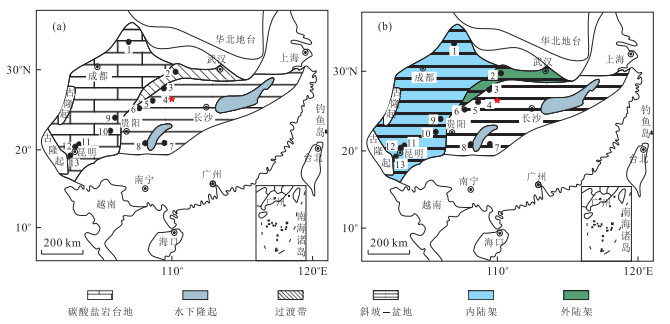
 下载:
下载:
